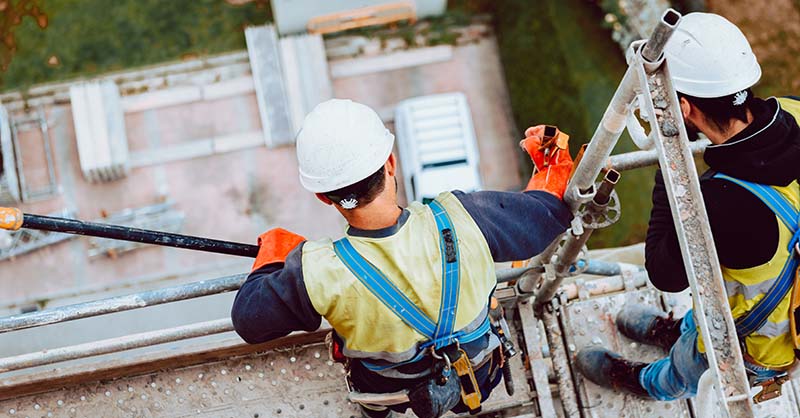Strategies to Help Prevent Fatal Falls in Construction

Falls from heights are the leading cause of death in the construction industry, according to the Federal Occupational Health and Safety Administration (OSHA). The Bureau of Labor Statistics (BLS) reported 1,008 construction industry fatalities in 2020. Of those fatalities, 351 (or 35%) were fatal falls to a lower level.
Construction work can already be dangerous, and much of it is performed at elevation, which is why fall prevention is heavily emphasized in the industry.
How high before a fall becomes fatal?
Multiple factors determine if a fall is fatal, but a fall from elevation can be deadly at just four feet above a surface.
An object can free fall 16 feet in just one second and accelerate to 21.92 miles per hour (mph) in the same amount of time, regardless of that object’s weight. It doesn’t take a falling person long to develop significant velocity when free falling, and higher velocity is a key contributor to bodily damage. This is because the impact at the conclusion of a fall causes damage to the human body, and that damage will be greater as higher impact forces act on the body. Other factors, such as age, body mass, landing position, etc., can also be variables that can increase bodily damage.
Three Ways You Can Help Prevent Falls on Your Construction Site
It's critical to prevent falls from happening on the construction site or at least significantly decrease the force at the conclusion of a fall.
1. Implement Fall Prevention and Fall Protection Measures
Not all forms of fall prevention are the same, and it takes a thorough understanding of how each fall prevention method works so that the appropriate fall prevention is selected and used.
It’s also important to understand the difference between fall prevention and fall protection.
Simply put, fall prevention (restraint) is planning and acting to remove exposures to falls, and fall protection (arrest) prevents injury to a worker who has fallen.
Fall Protection
Fall protection is equipment used to minimize injury from a fall but permits the fall to occur. Fall protection is commonly in the form of a fall arrest system.
Examples of Fall Protection
- Personal Fall Arrest Systems
- Aerial lifts
- Positioning Devices
For comprehensive insights into fall protection, encompassing OSHA regulations and actionable measures for integrating fall protection within your organization, explore our Fall Protection guide.
Access Your Guide to Fall Protection
Fall Prevention
Fall prevention (or restraint) removes the potential for falls. Examples include guardrails and lifelines that restrict physical access to a potential fall area.
Examples of Fall Prevention Systems
- Guardrails
- Warning lines
- Fall Restraint Systems
Access Your Guide to Fall Prevention
2. Train Your Personnel for Success
After planning fall management on the job site and providing fall prevention/protection equipment, training is needed so that everyone understands:
- Expectations for safety on the job site.
- All areas and/or types of work where fall prevention/protection is required.
- How to properly use and maintain fall prevention/protection equipment.
- What to do if there is a problem with the equipment or if working conditions change unexpectedly, including “stop work” situations.
All levels of site employees need to be trained according to their role on the job site. This includes:
- Site Leadership
- Managers and Superintendents
- Site Workers
- General Labor
Train all workers before work commences. Everyone plays a role in site safety.
3. Establish Accountability on the Construction Site
The final part of any successful fall prevention and protection program is establishing accountability, which is critical in creating a culture of safety on the job site. Lack of accountability can lead to the development of gaps in all areas of safety. Gaps are the space between the established safety policies/procedures and the actual behavior of workers at any given time. The goal is to have no gap between what workers are supposed to do and how they do it and what they are actually doing.
Site management must effectively mind every gap in a timely fashion, especially when it comes to fall prevention/protection. There is no margin for error.









